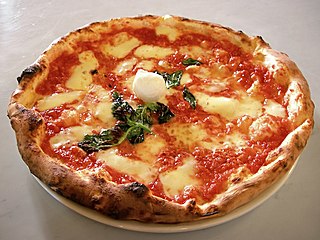
Neapolitan sauce, also called Napoli sauce or Napoletana sauce, is the collective name given to various basic tomato-based sauces derived from Italian cuisine, often served over or alongside pasta.

Pizza is a traditional Italian dish typically consisting of a flat base of leavened wheat-based dough topped with tomato, cheese, and other ingredients, baked at a high temperature, traditionally in a wood-fired oven.

Tomato sauce can refer to many different sauces made primarily from tomatoes, usually to be served as part of a dish, rather than as a condiment. Tomato sauces are common for meat and vegetables, but they are perhaps best known as bases for sauces for Mexican salsas and Italian pasta dishes. Tomatoes have a rich flavor, high water content, soft flesh which breaks down easily, and the right composition to thicken into a sauce when stewed, without the need for thickeners such as roux or masa. All of these qualities make them ideal for simple and appealing sauces.

New Haven–style pizza is a style of thin-crust, coal-fired Neapolitan pizza common in and around New Haven, Connecticut. Locally known as apizza, it originated in 1925 at the Frank Pepe Pizzeria Napoletana and is now served in many other pizza restaurants in the area, most notably Sally's Apizza and Modern Apizza. This geographically limited pizza style has been favorably regarded by national critics.

Spaghetti alla puttanesca is a pasta dish invented in Naples in the mid-20th century and made typically with tomatoes, olive oil, olives, anchovies, chili peppers, capers and garlic, with vermicelli or spaghetti.

Pizza Margherita or Margherita pizza is a typical Neapolitan pizza, roundish in shape with a raised edge and garnished with hand-crushed peeled tomatoes, mozzarella, fresh basil leaves, and extra virgin olive oil. The dough is made by mixing water, salt and yeast with flour.

Sofrito, sofregit, soffritto, or refogado, is a basic preparation in Mediterranean, Latin American, Spanish, Italian and Portuguese cooking. It typically consists of aromatic ingredients cut into small pieces and sautéed or braised in cooking oil for a long period of time over a low heat.

Italian-American cuisine is a style of Italian cuisine adapted throughout the United States. Italian-American food has been shaped throughout history by various waves of immigrants and their descendants, called Italian Americans.

Garlic knots are a type of garlic bread found primarily in pizzerias around New York City and the surrounding regions. They were developed in the 1940s in Brooklyn. Many pizzerias claim to be the progenitors of the baked good.

The history of pizza begins in antiquity, as various ancient cultures produced flatbreads with several toppings.

A San Marzano tomato is a variety of plum tomato originating from the Campania region in Italy. It is known for its flavour and quality as a canning tomato. San Marzano production is protected by a European protected designation of origin certification.

Neapolitan cuisine has ancient historical roots that date back to the Greco-Roman period, which was enriched over the centuries by the influence of the different cultures that controlled Naples and its kingdoms, such as that of Aragon and France.

Marinara sauce is a tomato sauce usually made with tomatoes, garlic, herbs, and onions. Variations include capers, olives, spices, and a dash of wine. Widely used in Italian-American cuisine, it is known as alla marinara in Italy, where it is typically made with tomatoes, basil, olive oil, garlic and oregano, but also sometimes olives, capers, and salted anchovies. It is used for spaghetti and vermicelli, but also with meat or fish.

Neapolitan pizza, also known as Naples-style pizza, is a style of pizza made with tomatoes and mozzarella cheese. The tomatoes must be either San Marzano tomatoes or pomodorini del Piennolo del Vesuvio, which grow on the volcanic plains to the south of Mount Vesuvius. The cheese must be mozzarella di bufala campana, a protected designation of origin cheese made with the milk from water buffalo raised in the marshlands of Campania and Lazio in a semi-wild state, or fior di latte, a cow's milk mozzarella created according to the procedure for which it was registered as a traditional speciality guaranteed (TSG). Pizza napoletana is a TSG product in the European Union and the United Kingdom, and the art of its making is included on UNESCO's list of intangible cultural heritage.

Carne pizzaiola or carne alla pizzaiola, sometimes referred to just as pizzaiola, is a dish derived from the Neapolitan and Apulian tradition that features meat cooked with tomatoes, olive oil, garlic, and white wine long enough to tenderize the meat. Most versions also include tomato paste, oregano and basil.

The traditional cuisine of Abruzzo is eclectic, drawing on pastoral, mountain, and coastal cuisine. Staples of Abruzzo cuisine include bread, pasta, meat, fish, cheese, and wine. The isolation which has characterized the region for centuries has ensured the independence of its culinary tradition from those of nearby regions. Local cuisine was widely appreciated in a 2013 survey among foreign tourists.
Tutta Bella Neapolitan Pizzeria is an Italian restaurant chain with six locations in Washington, United States. The first location was founded in 2004. The restaurant specializes in "authentic" Neapolitan pizza and is certified by the non-profit Associazione Verace Pizza Napoletana which certifies pizzerias that use traditional ingredients and processes. Tutta Bella was the first restaurant in the Pacific Northwest to receive such certification.
Acunto Napoli Ovens is an Italian artisanal pizza oven manufacturer based in Naples, Italy. It was founded in 1892 by Vincenzo Acunto and is currently operated by Gianni Acunto.















